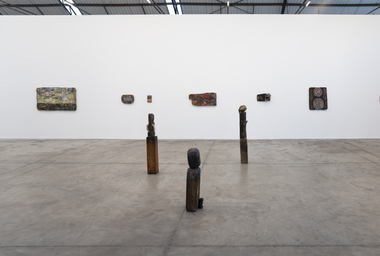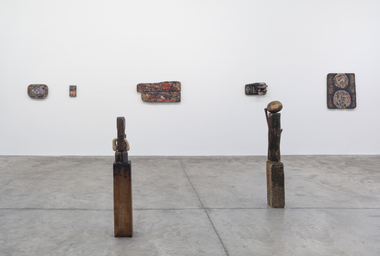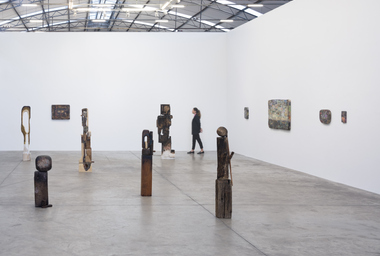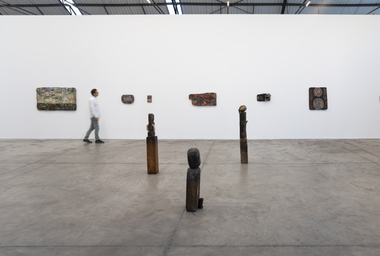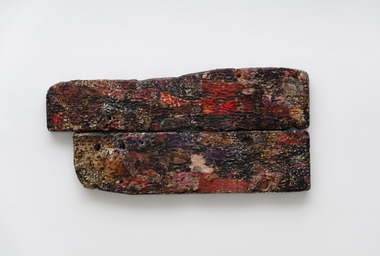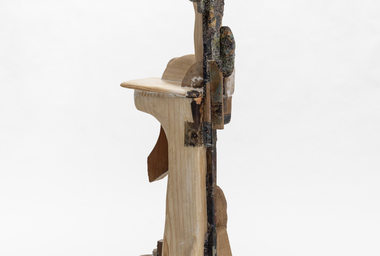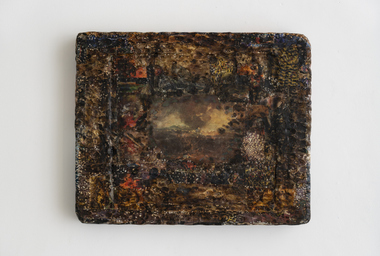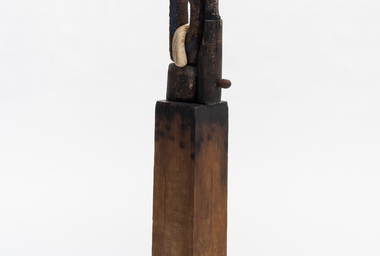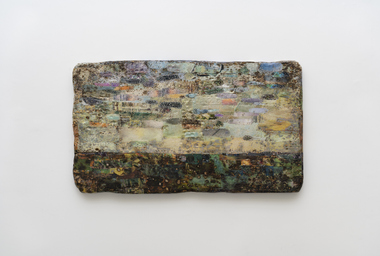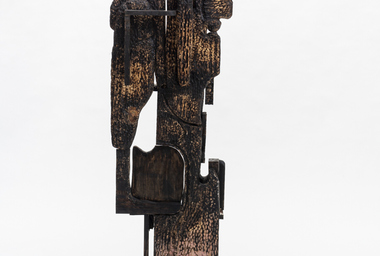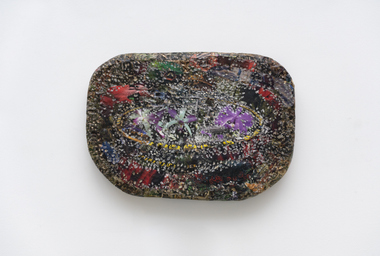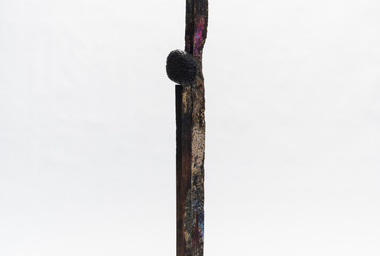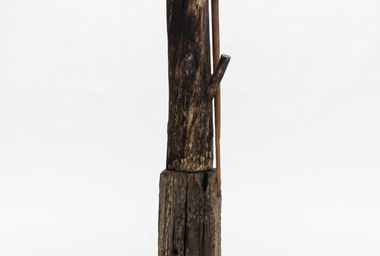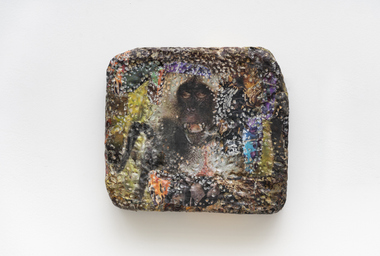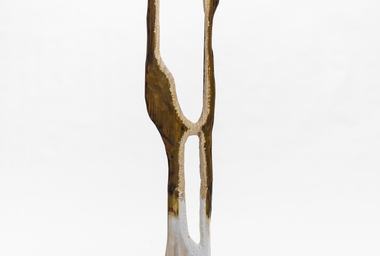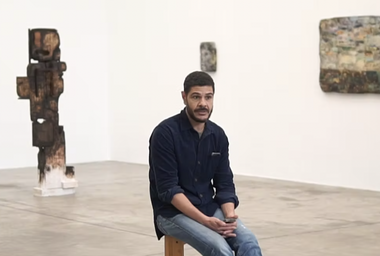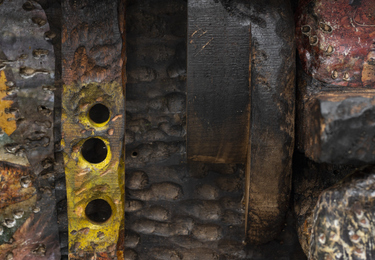
Anderson Borba
I’ve seen one of these
Jun 25 – Aug 13, 2022
Opening
Jun 25, 3 pm–6 pm
FDAG Barra Funda
Download
In his first exhibition in Brazil, Anderson Borba (Santos, 1972) presents a set of about twenty works. A Brazilian who has lived in London for two decades, the artist moved temporarily to São Paulo, where he has dedicated himself to the production of sculptures and wall reliefs that show his unique approach to the use of wood as the raw material of his practice. His pieces are carved, burned, and perforated manually by the artist using saws, chisels, and a blowtorch. A pictorial layer partially covers the surfaces in a peculiar process of painting and collage that employs cut-outs from diverse images, from queer culture to ethnography, from mainstream media to personal archives. Victor Gorgulho pens the exhibition essay that accompanies the show.
I’ve seen one of these
By Victor Gorgulho
Marked by a strong sense of physicality, Anderson Borba’s sculptures are very often on a quasi-human scale, facing up undauntedly to those who look at them. In front of them, it feels as if we are being struck by undeniably hybrid sensations, between the familiar and the completely unknown, between attraction and strangeness. Borba’s sculptural process seems to consciously feed a desire for a hybrid territory, deliciously instable, but absolutely consistent, concrete.
In his essay Specific Objects from 1965, American artist Donald Judd talks unforgivingly about an ongoing transformation with regards to the conventional, so-called canonical practices under which mediums such as painting and sculpture were still being produced at the time. In his conceptual examination of new approaches to these mediums – historically reliant on primarily Eurocentric conventions – Judd states: “Half or more of the best new work in the last few years has been neither painting nor sculpture”.
Far from trying to deny, or even surpass, the use of these mediums in the artistic practices of the time, Judd seems to be talking about the disruptive interpellations that several artists were beginning to incorporate into their work. “[…] Now painting and sculpture are less neutral […], anything in three dimensions can be any shape, regular or irregular, and can have any relation to the wall, floor, ceiling, room, rooms, or exterior or none at all”, concludes the artist, an emblematic figure in the minimalist movement of the time.
Despite the obvious time gap between the two artists, Judd’s ideas somehow resonate with Anderson Borba’s work. Born in Santos, Brazil, and now living and working in London for more than two decades, Borba elects different objects, fragments and pieces of wood, from several sources, to become his main raw materials, leading a sculptural practice that is largely conjured by agglutinating and sticking together these fragments, guided more by listening to the materials than by focusing on producing something planned a priori, or mentally or practically drafted. Therefore, it is here that any kind of parallel between Judd and Borba falls through: whilst the American minimalist is renowned for a body of work where the use of industrial materials was a rigid and previously planned strategy, Borba’s sculptures are the result of an intimate process between the artist and his materials, which spans from their gathering to the works’ final forms.
Borba takes his practice to a borderline region, which allows him to combine references that range from the Brazilian popular sculpture tradition to a variety of contemporary practices. If, on the one hand, we can identify the vernacular use of materials in his production, on the other hand, we also see a contemporary devotion to images – images that come from a myriad of sources, most often taken from scientific magazines, or ethnographic images and images linked to the queer universe. This is the sort of fraying that we are here calling the “hybrid territory” of his work.
After an extensive period of manual labor dedicated to wooden pieces, Borba began to use an ingenious method of sticking multiple images onto the surface of his sculptures, which, in turn, absorb the paper as a type of skin, like eccentric garments covering their full nudity. Here, we have one of the aspects that perhaps can objectively explain the disconcerted feeling mentioned earlier. In Borba’s practice, collage does not produce the obvious or the predictable. From the nature of the chosen images to the way in which they are combined on the wooden surface, nothing here evokes the conventional procedures of this field.
Perhaps, partly because the artist never completely abandons the process of sculpting his pieces – using his tools to make holes, cuts, gaps, openings, etc. – the images that lie on the wooden skin acquire dubious aspects, at times pictorial and at other times unrecognizable, in a singular process of assemblage that juxtaposes them in enigmatic compositions, often revealing only pictorial-chromatic outlines or sometimes something closer to figurative shadows, recognizable only by close observers.
If we are talking here about a sculptural practice that primarily takes place in the three-dimensional field, claiming the exhibition space with unsuspected strength and presence, it is also important to talk about Borba’s wall reliefs, works conceived for the two-dimensional plane. Perhaps these are the works that most strongly trigger our senses as they come closer to an almost-abstract pictorial nature. In Após a tempestade [After the Storm] (2022), we see an irregular rectangular panel, where the images applied to the wood stops us from drawing fortuitous or fast conclusions. Is it painting?, we ask ourselves in silence. Perhaps an abstract landscape?, we carry on with our endless questioning.
In works such as Grizzly (2022), another sculptural relief, the artist makes sure the figurative presence of a monkey is explicit. Surrounded by a whole range of colors perforated by his tools, only the mammal’s face is recognizable. It is this constant process of trying to recognize the creatures built by Borba that the exhibition title refers to. Borrowed from the title of one of his earlier works, I’ve Seen One of These is a direct response to this optical-cognitive gap that envelops the spectator. We understand – after appreciating the work for a short period of time – that we are faced with a body of works that are ontologically difficult to categorize.
We presume we have seen some of these beings before, many of which – naturally – flirt with the anthropomorphic, bearing an objective resemblance to living beings, either human or non-human. Tudo o que a boca come [Everything that the Mouth Eats] (2022) makes this dimension very clear both in the title and in the work’s visual composition. We see a large oval orifice (a face, or a mouth?), a languid wooden piece that sensually leans over the two sides of the work. If, as previously mentioned, Borba’s practice evokes Brazilian popular tradition – flirting with names such as José Bezerra, Agnaldo dos Santos and many others – it is also related to the practice of contemporary figures who are fundamental to the understanding of the expansion of the material and semantic possibilities within the field of sculpture, such as the artists Ivens Machado, Martin Puryear and Alexandre da Cunha, to name only a few.
However, there is a peculiar characteristic that is intrinsic to Borba’s work. If the conventional understanding of the making of sculpture sees manual labor as a direct physical relationship between the hands of the artist and the material they choose to work with, here we are witnessing a deviation from the norm. Between the artist’s hands and the wood, there is always the irrevocable mediation of one of his many tools: chisels, gouges, blowtorches, and even electric saws.
Amongst these, perhaps the one that Borba uses in the most distinctive way is the blowtorch. With sculptures erected as vertical or horizontal structures – applying a formal gesture that is as radical as it is precise – the artist uses the fire produced by the tool to burn some of his works, adding new nuances to the complex palette of colors and shades of a piece of wood. Darker or brighter, denser or lighter, they are all presented as a cohesive set, which sometimes acquire last-minute small ornaments. Pieces of rope, small quantities of natural pigment and other micro-additions are made by the artist while still in the studio.
After some time spent in the presence of Anderson Borba’s sculptures, there is a sudden emptying of that first feeling of unsettling unfamiliarity instilled in us by those creatures we are looking at. We have seen some of them before: not exactly like the ones presented to us now, but, to some extent, as figures that are familiar to our eyes and brains, which will very likely be retained for days and weeks to come. We have definitely seen one of these before, we think. Not only have we seen them before, we remember them, like old friends that we haven’t seen in a while, but that are somehow preserved in a remote region of our brain. We exhale in relief, we attempt a timid smile, almost as if greeting these (un)known strangers.
